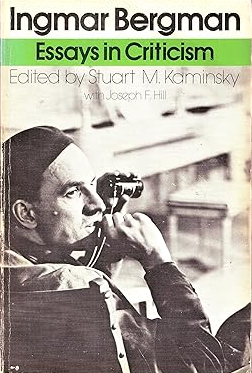
“When the French film-maker François Truffaut was first exposed to the films of Swedish director Ingmar Bergman he said: ‘Here is a man who has done all we dreamed of doing. He has written films as a novelist writes a book. Instead of a pen he has used a camera. He is an author of cinema.’ Bergman himself has said: ‘The motion picture, with its complicated process of birth, is my method of saying what I want to say to my fellow men.’
“Bergman has used his camera to compose a continuing essay on man’s relationship to God in the context of the problem of evil. Two things have influenced Bergman’s film-making. One is his background in the theater, which accounts for his expert handling of the repertory of film actors he has built up.
“The other is his early upbringing as the son of an Evangelical Lutheran pastor, which accounts for his preoccupation with the more somber side of religious truth in his films. As early as 1948, in The Prison (American title: The Devil’s Wanton), one of his characters reflects that ‘if one can believe in God, there is no problem; if one cannot, there is no solution.’ . . .
“[I]n many of Bergman’s films belief in God is reaffirmed only after a character has been dealt a staggering blow which brings him literally to his knees in resignation to the God he cannot hope to understand in this life. This is true of The Virgin Spring (1960), which won a U.S. Academy Award. The film is based on the medieval tale of a young girl who is raped and murdered on her way to Mass by two brutish shepherds. When the girl’s father (played by Max von Sydow, who was also Antonius Bloch [in The Seventh Seal]) discovers the deed he reverts from his Christian beliefs to his pagan ways and brutally kills not only the two shepherds but their younger brother who had no hand in their crime.
“Then, kneeling near his daughter’s body and realizing how his own crime has matched that of the shepherds, he prays, ‘You saw it, God. The death of an innocent child, and my vengeance. You permitted it, and I don’t understand you. Yet I now ask you for forgiveness — I do not know of any other way to reconcile myself with my own hands. I don’t know of any other way to live.’
“A spring of water then bubbles forth from where his daughter’s body had lain. After this strong affirmation of God many thought that Bergman would now begin to examine the more positive aspects of religious belief. Instead Bergman next mounted a trilogy which shows how people who fail to reconcile themselves with other human beings cannot reconcile themselves with God. ‘Most of the people in these three films are dead, completely dead,’ he explains. ‘They don’t know how to love or to feel any emotions. They are lost because they can’t reach anyone outside of themselves.’
“The three films are Through a Glass Darkly (1961), which won an Academy Award; Winter Light (or The Communicants, 1963); and The Silence (1964). Some critics were somewhat dismayed because the characters in the three films get further and further out of touch with God and man in each succeeding film. Yet the fact that the films treat the loss of faith rather than the finding of faith is no reflection on Bergman’s own beliefs. The theme of each film would be the same had they been made in reverse order. As they stand, the need for human and divine love is stressed more strongly in each film in proportion to the absence of both in the characters of each film. . .
“Basically, Bergman seems to be saying in his films, when we look at them as a group, that the coexistence of good and evil is all that we can hope for from our fragmented existence. Moreover he seems to imply that life is easier to bear when one is willing to take the risk of communicating with others and seeking union with them. One cannot hope to establish a relationship with God by bypassing fellow human beings.
“But Bergman avoids being explicit in stating messages or meanings in his films. In his preface to the published edition of Cries and Whispers he says, ‘As I turn this project over in my mind it never stands out as a completed whole. What it most resembles is a dark flowering stream: faces, movements, voices, gestures, exclamations, light and shade, moods, dreams; nothing fixed, nothing really tangible other than for the moment, and then only appearing to be. A dream, a longing or perhaps an expectation, a fear, in which that to be feared is never put into words — I could go on indefinitely describing key and color, but we shouldn’t be any wiser.’
“His chief interest, then, is to present the problems of human existence for filmgoers to ponder in order that they can come to their own conclusions, for he does not pretend to be able to make anyone any wiser. When he is asked the general purpose of his films he replies with a parable about the medieval artists who contributed their efforts to the building of the great cathedrals: ‘I want to be one of the artists in the cathedral on the great plain. I want to make a dragon’s head, an angel, a devil — or perhaps a saint — out of stone. It does not matter which; it is the sense of satisfaction that counts. Regardless of whether I believe or not, whether I am a Christian or not, I would play my part in the collective building of the cathedral.’”
— from Gene D. Phillips, S.J., “Ingmar Bergman and God,” in Ingmar Bergman: Essays in Criticism, edited by Stuart M. Kaminsky (Oxford University Press, 1975)